Making Gâteau Battu
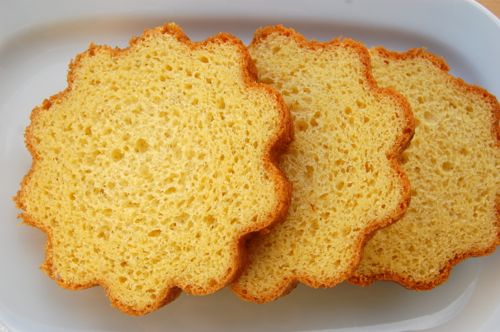
For sheer simple beauty, there’s no beating (no pun intended) a slice of gâteau battu. The brioche family of breads is like that. They’re golden in color and can be baked in all sorts of elegantly shaped molds. Gâteau battu differs from brioche mainly in its flavor — which is significantly sweeter — and its texture which is extremely tender and moist. Especially when topped with custard, jam or some other sweet spread, it truly lives up to it’s designation as a cake (versus a bread). Start by making the sponge. Combine the yeast, egg and flour…

…and stir.

Let the mixture ferment for an hour until it’s nice and puffy (don’t worry about the grains of yeast on the surface, they’ll dissolve in the mixing step).
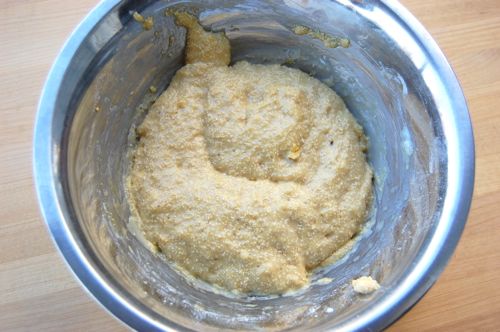
Combine the sponge with the rest of the ingredients (save for the butter) in a mixer with a dough hook attached. Knead for 5-7 minutes until the mixture comes together in a sticky dough that gathers around the hook yet still sticks to the bottom of the bowl.
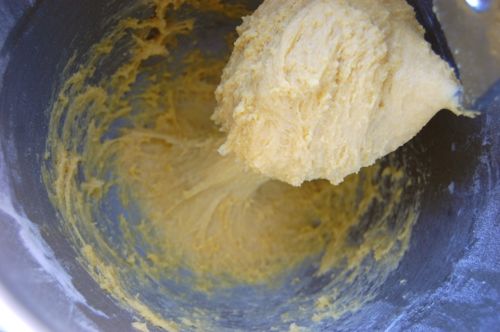
Next add the soft butter about 2 tablespoons at a time until you’ve got a light, sticky dough.

Scrape it into a lightly oiled bowl. Cover it with plastic wrap and let it sit for two hours…
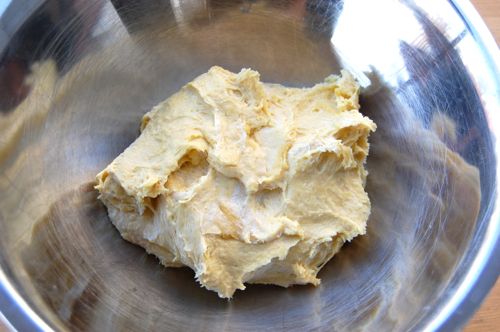
…or until it looks like this:
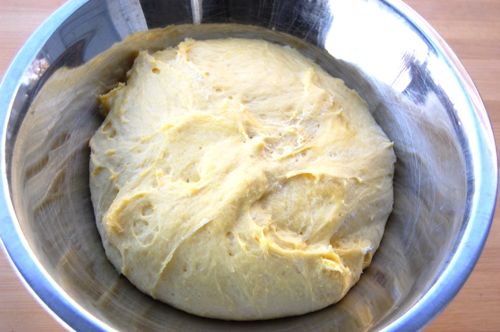
Transfer the dough to a gâteau battu mold, tall brioche mold or even a standard 10″ loaf pan, where it will still work splendidly.
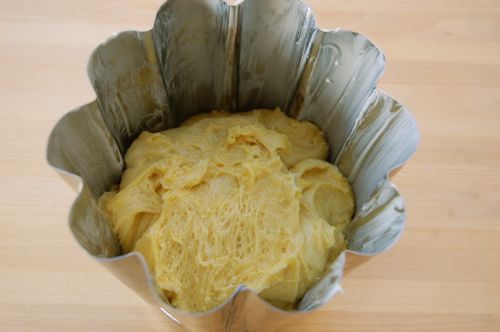
Let it rise an hour, until it’s about an inch below the lip of the form. Meanwhile preheat your oven to 325 degrees Fahrenheit and set a rack on the lower middle of the oven.

Bake the gâteau for 50 minutes or so until it’s well browned on top. You can tent it with aluminum foil after about 40 minutes if it seems to be getting too brown.
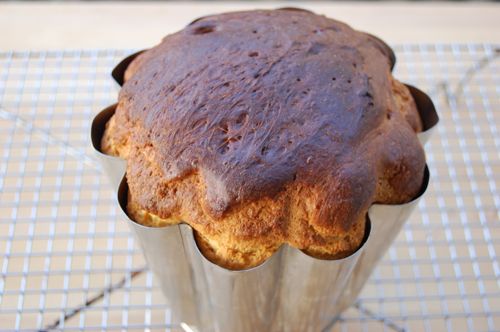
It should rise about an inch and a half over the lip of the form. Cool it for at least two hours before slicing. It will actually keep very, very well left in the form unsliced for two or even three days. All that sugar and fat, donchaknow.
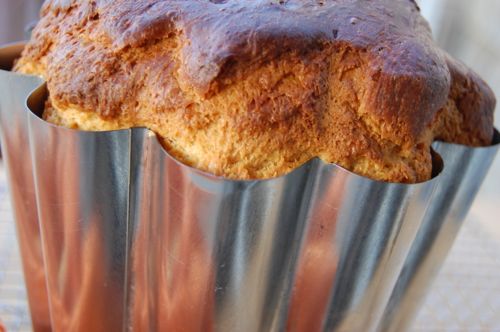
When you’re ready to serve, turn the beast on its side and cut it into half-inch slices.
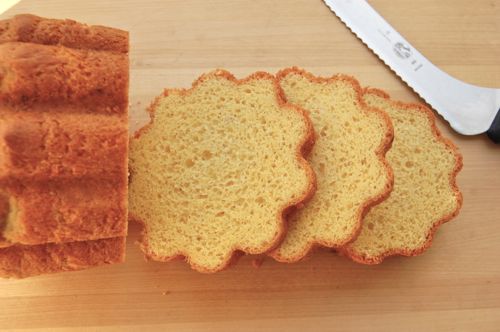
Gâteau battu is traditionally served with simple custard slathered all over it. Jam is another excellent way to go.
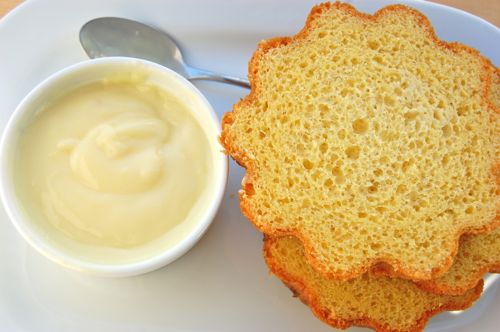
These dainty little sandwiches have something else inside them.
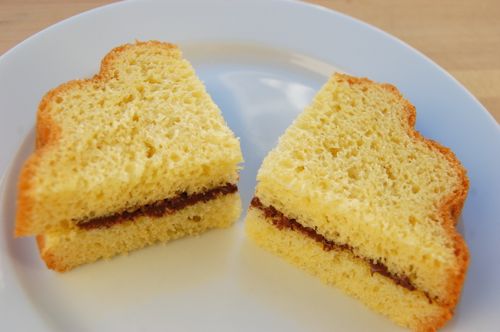
Whichever way you go with this, it’s almost impossible to go wrong. Make any stale leftovers into French toast!
This is utterly gorgeous! Do you need to use a kitchen aid or can you use a hand mixer / some other method?
If you don’t mind getting messy, just use your hands! 😉
– Joe
Success at last – well done, Joe!
I am thinking that gateau battu is sort of a smaller version of Italian pandoro, is that right?
Thanks for the custard/pudding recipe as well – I too have a cold and may just have to toddle down to the kitchen to make a batch 🙂
It’s good for what ails you, Jen. But yes, it is similar to pandoro, there’s no question. There are a lot of these big eggy breads in the European tradition generally. One of them is pannetone which — though it may seem redundant — I hope to do before Christmas this year. We’ll see.
– Joe
It’s strange – when I lived in Italy, I had people swear that pandoro and panettone had very different doughs (aside from the fruit in the panettone, of course). But I could never discern much of a difference, except perhaps a bit more sweetness in the pandoro, although that could have been from the icing sugar. I would be very curious to know if there is in fact a difference!
Hey Jen!
To my mind the difference is that pandoro is made with a sponge and pannetone — at least traditionally — is made with a starter (what we might call a “sourdough starter” or “barm starter”). That gives pannetone a denser crumb with a more complex flavor — usually. These days there are lots of fast-produced pannetone iterations out there that don’t employ traditional methods. But even under the best of conditions the difference between pandoro and pannetone would be mostly lost on people that didn’t grow up making or eating them. But I think pandoro is generally fluffier and pannetone is denser and chewier. That’s pretty much all I know!
– Joe
Yay! I was thinking of emailing you and requesting panettone as another project somewhere in here; I’ve wanted to try making it for a while, and your recipes haven’t gone wrong for me yet.
I’ll try not to let you down, Jane! 😉
– Joe
Hi Joe. Bravo… nice looking gateau! My reading comprehension may not be what it should be, but is it fair to conclude that using the sponge technique is as good or better than using an osmotolerant yeast? I’m hoping because I have lots of regular yeast and none of the osmotolerant type… and I want to mimic the Joe Pastry successes without having to seek out specialty items if at all possible.
Hi Brian!
Thank you…it’s been a long journey. Yes indeed, this method is probably quite a bit better than simply using osmotolerant yeast. Even with a sugar-tolerant yeast, you’d still be facing an uphill battle when mixing the dough. This way you get a thriving culture going before the yeast meets the sugar (and/or alcohol). I’m grateful to all the readers who encouraged me to try that…it worked like a charm! Have fun — and let me know how yours turns out!
– Joe
This looks fantastic. Am waiting for more christmas recipes..:-)
I’ve got a couple of ideas about that, Geetha! More soon!
– Joe
You did it! I expected no less from a fearless baker such as yourself. I am excited to make this for Christmas, as I am not a fan of all the fruit chunks in our yearly Panettone. 🙂
Let me know how yours goes, Ann! I’ll be interested.
– Joe
Dear Joe,
Perhaps I’m being dense and perhaps it is my browser, but I can’t find a list of ingredients for your gâteau battu. Where should I be looking?
You’re not being dense at all, Craig. This has taken me so long, the recipe post scrolled off the page. If you go over to the left to the “Pastry” menu, you’ll find both the tutorial and the recipe bundled together, with the recipe at the bottom. Let me know if you have any other questions! Cheers,
– Joe
Oh phew! I’m pleased to hear that you have had success. For all your hard work I shall be sure to try this… need a suitable form… Thank you for the reminder on the vanilla pudding – my daughters are feeling nostalgic for foods from their youth.
I hope you feel better from your cold soon.
I’m already feeling a little better, Connie. Thanks. Good vanilla pudding does that.
– Joe
This is a beautiful bread and I can’t wait to try it. However, in the photo you show the sponge consisting of egg, yeast and flour. The recipe says egg, yeast and milk. Is flour added to the sponge, and if so how much? Thanks for all your detailed photos and recipes. They make baking a lot easier.
That was my mistake, Bina…it’s fixed now. Sorry about that!
– Joe
Finally!
Well done, Joe!
Tell me about it!
But thank you…
– Joe
Oh wow! This is just absolutely beautiful – might have to delve into some baking for this weeked =)
Hey Peggy — try it! Now that the bugs are worked out, it’s really a very easy thing to do!
– Joe
WOW! It looks amazing, Joe. Hats off to you for pushing the boundaries and hence inspiring us to get off the couch and try 🙂
Thanks Malini! I think I’ve worked the bugs out, so you shouldn’t have any trouble. Go for it and let me know what happens! 😉
– Joe